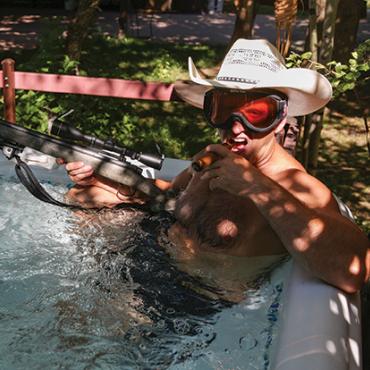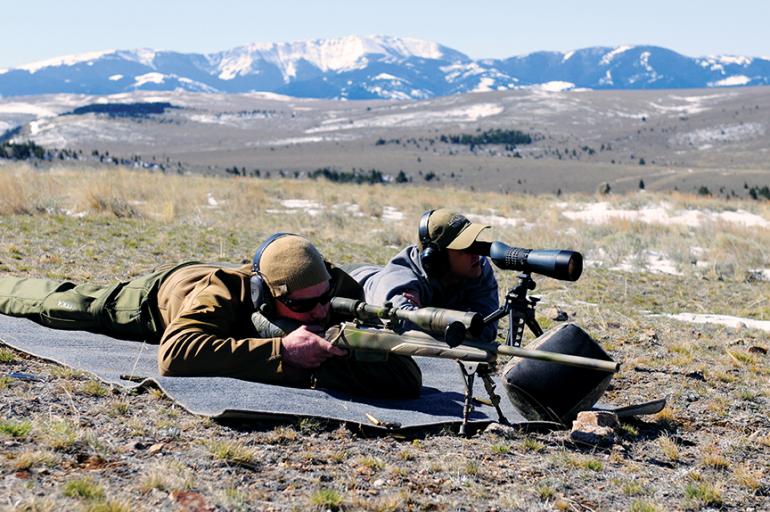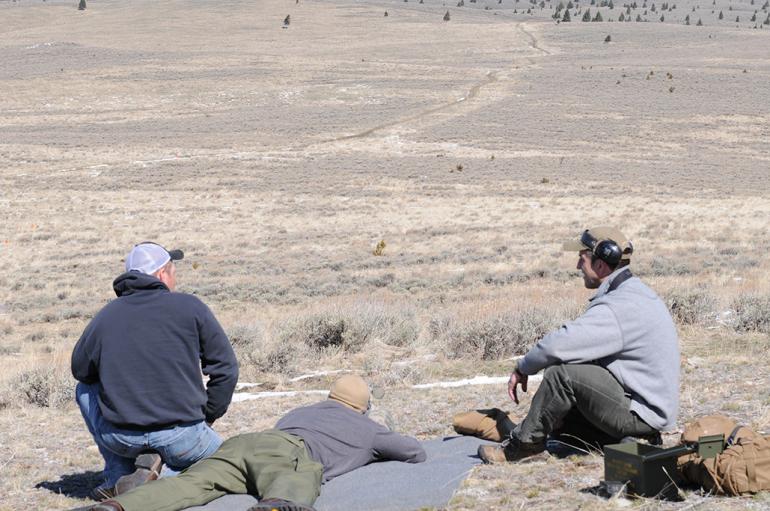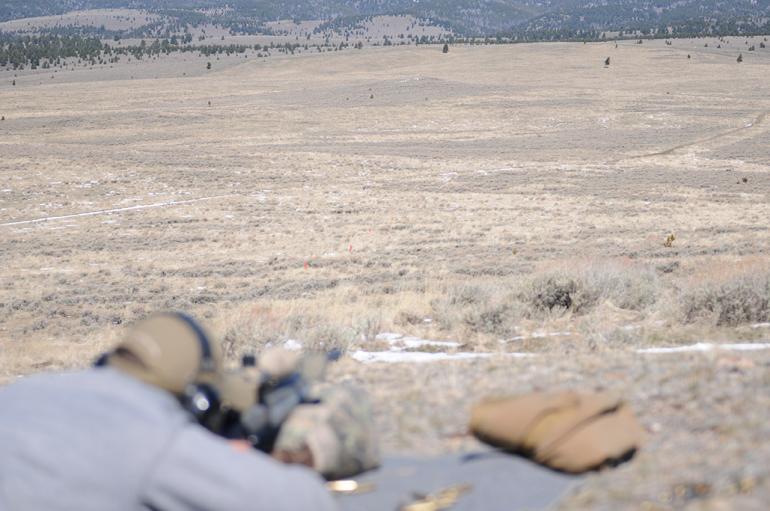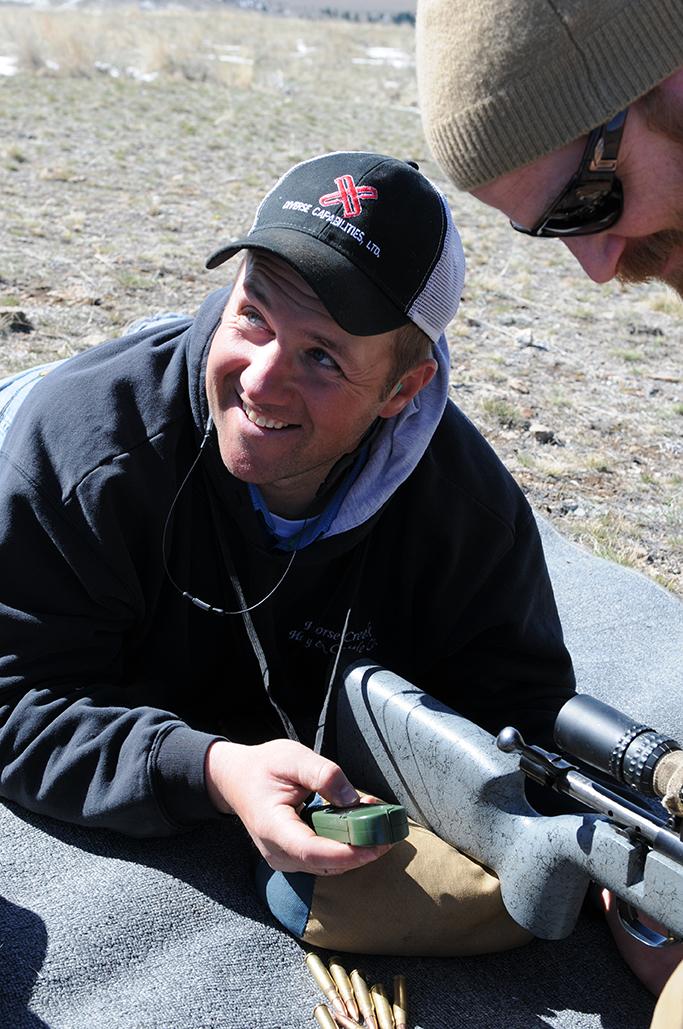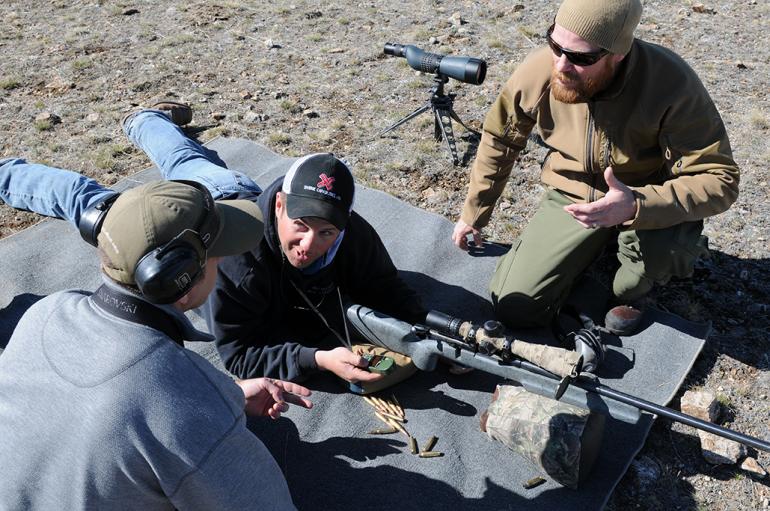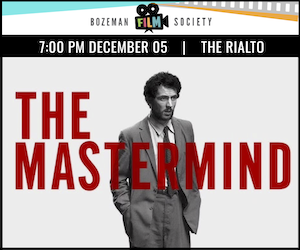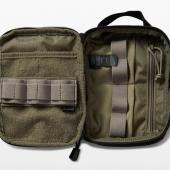Shooting School
Repentance and redemption at the Granite Creek Range.
The shriek of a red-tailed hawk fills the air as I relax and settle into position. Spilling out before me is a series of targets: orange silhouettes the size and shape of a human torso, one after another, from 100 yards all the way out to 900. I rest the crosshairs on the second one and take a long, deep breath.
“Nice and easy,” Bill says. “Take your time.”
My finger moves to the trigger; I exhale slowly and squeeze.
“Hit!” Peering through a spotting scope, Bill calls the shot a split-second before the telltale ping of lead on steel reverberates across the slope. “Dead center,” he says. “Let’s go to 300.”
As I dial in the scope for 300 yards, I glance around. A vast expanse of grass and sagebrush sprawls out below us, broken only by subtle undulations in the terrain and a few stunted evergreens. Snow-capped peaks rise to the north and south, while behind us a maze of rugged, juniper-flecked ravines spill down into the Madison Valley. On the eastern horizon, the mighty Sphinx stands tall. “Pretty nice country,” I observe, seating the rifle back into my shoulder. Bill smiles and nods his head. “Not a bad place to shoot, is it?”
Not bad at all. Which may be why shooters from around the country come here, to the Granite Creek Range on the southern flank of the Tobacco Roots, to work on their long-range shooting skills. Among the regulars at Granite Creek are SEALs, Air Force Pararescue troops, and other elite military units. They like the high-elevation conditions, variable wind patterns, and the ability to shoot at an angle—say, from atop a rocky escarpment to the bottom of a canyon far below. These conditions simulate what a sniper might find in the craggy peaks of Afghanistan or Pakistan—and, of course, what an elk hunter might face in the mountains of Montana. And that’s why I’m here, lying in the sagebrush, blasting away at metal upper-bodies a quarter-mile away: to become a better hunter. Because a good hunter is a good shot.
A missed shot weighs hard on a hunter. It sits in the gut, heavy and indigestible. It feels like a sin—against the animal, against the spirit of the hunt, against oneself. Because poor marksmanship doesn’t just mean ineptitude and lost opportunity. It presages something far worse, something criminal: a wounded animal, a long and painful death, a bloated carcass rotting in the woods. Which, ultimately, means failure—to respect the animal and live up to the code of honor by which every hunter is bound.
Several years ago I’d missed an elk—a mature bull at 300 yards—and I’d never quite gotten over it. Like Robert De Niro in The Deer Hunter, I’d slumped against a tree and screamed my dereliction into the cold alpine air. I went home, threw out my tag, and hung up my rifle for the season.
The next year I missed a whitetail doe; the year after that, an antelope. The sins were adding up. It was time to do my penance.
Standing behind me, Bill evaluates my position. “Line up behind the rifle,” he says. “Spread your legs. Feet flat to the ground.” Eventually I’m in a sturdy, stable position, pointed straight at my target. “Now press your cheek into the stock,” he says, stressing the importance of good shooting fundamentals. “Get a good weld. Move your eye around until there’s no shadow in the scope."
One by one, he eliminates my weaknesses, smooths out my rough edges. If anyone’s in a position to do so, it’s Bill Wood. A former competitive shooter, with numerous accolades to his credit—including eight years on the U.S. National Team and a silver medal at the World Championships—Bill has put more rounds downrange than the entire Bozeman police force. He was on track for the 2008 Olympics when his event—moving targets—was eliminated. After a decade of shooting in professional matches around the world, Bill found himself back in Sheridan, guiding elk hunts and working on the family ranch. But shooting was in his blood, and he soon found his way back to it by building custom rifles and doing shooting demonstrations for an ammunition company.
One thing led to another, and before long he and a partner had built a range on the family land, designed for both military and civilian use. Many of their customers are hunters, like me, but they also train recreational shooters. “We get a range of folks out here,” says Bill, “from the extreme hunter already capable to 500 yards, to the 65-year-old lady who thinks shooting steel is just plain fun.” They can all learn something, it seems, out here in the wide-open landscape with targets up to a half-mile away.
Not that I have any intention of shooting an elk at 900 yards. But being able to make good, clean hits at that distance offers a sense of confidence—which is precisely what I’d lost over the last few years. I was here to get it back.
Confidence may be the ultimate enigma: powerful yet intangible, both a reality and an abstraction. It’s the invisible force that propels a person beyond his limitations, like a sprinkling of magic dust. Quite often it makes the difference between success and failure. “Believe you can,” said Teddy Roosevelt, “and you’re halfway there.”
In shooting, the environment is an unknown variable, constantly in flux. A good shooter must therefore adapt his skills to this changing environment. Confidence comes from ability, and ability from practice. Practice out to 900 yards and you’ll be confident at 400.
Which is all a hunter needs, says Bill. “I regularly shoot out to 1,500 yards,” he says, “but the longest shot I’ve taken on an animal is 435 yards.” Numerous variables, he points out, affect a bullet’s trajectory: wind, temperature, humidity, elevation. “There’s just so much happening out there,” he explains. “When you’re shooting at something with a heartbeat, there can’t be any guesswork.”
Which is why he’s frustrated with contemporary hunting shows that depict long-distance shots on large game. “Those TV shows do a disservice to the hunting community. It makes people think they can buy a gun and a good scope and call it good. They don’t discuss all the other important elements.” Not to mention the dirty little secret often hidden from view. “The kill-shot may look cool,” he says. “But what you don’t see is how many elk they missed or wounded.”
So what’s the answer? According to Bill, it comes down to two things: good equipment and good fundamentals. And in the end, he says, “there’s no substitute for trigger time.”
The day’s wearing on, the sun slowly dropping toward the mountains to the west. I’ve fired some 200 rounds, which is 180 more than my usual sight-in session at the Logan range each September. Huge increase in trigger time.
Bill hands me his “Tactical Hunter,” a precision rifle he custom-builds for marksmanship-minded hunters around the region. “Let’s see what you’ve learned,” he says. “Start at 300 and work your way out.”
Start at 300? Images of that bull elk sprinting away unharmed, my bullet flying wide of his 800-pound body, flood my brain. I adjust my body position, weld my cheek to the stock, and shift my head until there’s no scope shadow. I take a deep breath, then slowly let it out, finger on the trigger. Slowly, carefully, gently, I squeeze.
“Hit!” A half-second later, the ping hits my ears.
I move to 400. Another hit. Then 500, then 600. With each hit, I feel more capable for the next. Bill gives me windage adjustments, and 700 and 800 go the same way. I look at Bill, incredulous. “Did I just hit six shots in a row, including an 800-yard target on the first shot, with a rifle I’ve never shot before?" “Sure did,” he says. “How’s it feel?” “Amazing,” I rejoice. “I don’t want to jinx myself, but I feel like I can’t miss.”
Bill gives me his guileless, small-town-Montana grin. “Let’s go to 9,” I say, and settle in for the last shot of the day. A light wind touches my cheek. My crosshairs find the target and slide right, settling just off the silhouette’s shoulder. The world around me slowly obliterates until only my breath exists. Inhale, exhale. Nothing more—I’m a freakin’ yogi with a gun, in full-on meditation. Inhale, exhale. My finger moves on its own. And I can hear the ping before the bullet even leaves the barrel.

